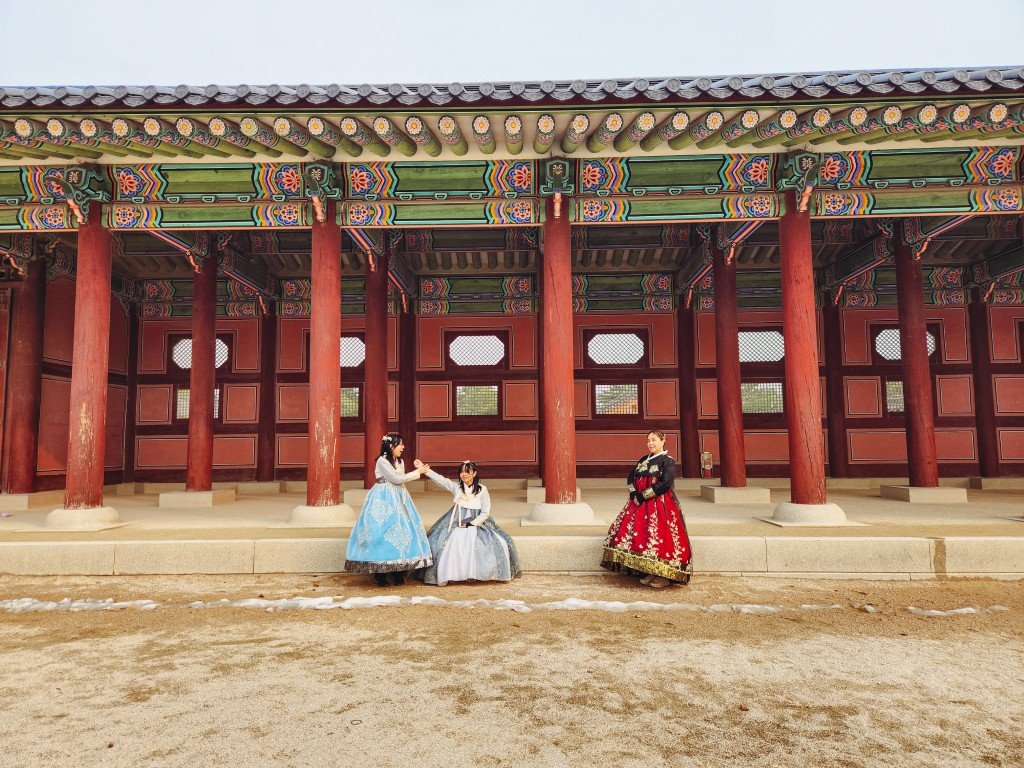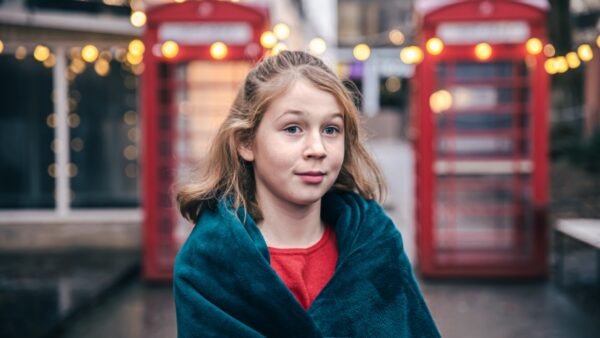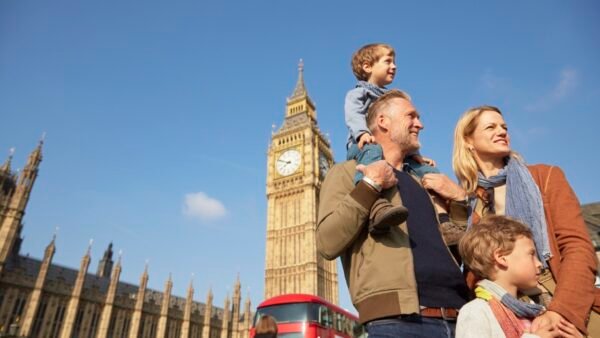Seoul is a fantastic family destination if you’re visiting South Korea with kids. While South Korea’s capital might be famous for K-pop and shopping, it’s packed with family attractions and kids’ activities that make it an ideal destination for family travel. Visiting Seoul with kids (well, technically, with our teens) for a week was definitely one of our favorite family vacations we swore we’d be back!
The last time I was in Seoul was 30 years ago, when I was a teen! It was kind of “meh” for me then, but today, Seoul has so much more to offer. This vibrant city seamlessly blends educational experiences with pure fun, offering everything from interactive museums to exciting theme parks. The best part? Seoul’s excellent infrastructure and family-friendly culture make traveling with kids surprisingly manageable.
Now, if you have teens or tweens, I suggest you check out our guide to Seoul With Teens, as it’s geared a lot more toward your older kids or even young adults. But if you have children much younger, this guide will help you plan an unforgettable Seoul family vacation. Let’s explore the best Seoul attractions for kids and create the perfect family itinerary for your Korean adventure.
Things to Do in Seoul With Kids
Before we dig deep into on what to do in Seoul with kids, here’s a quick run-down on the many kid-friendly attractions and activities to choose from:
- Theme parks: Seoul has two major theme parks: Lotte World and Everland. Both parks offer a variety of rides and attractions for all ages, including roller coasters, water rides, and shows.
- Museums: Seoul has a number of museums that are perfect for kids, such as the National Museum of Korea, the National Folk Museum of Korea, and the Children’s Museum of Korea. These museums offer interactive exhibits and activities that will teach kids about Korean history, culture, and art.
- Parks: Seoul has many beautiful parks, perfect for a leisurely stroll or a picnic. Some of the most popular parks include Seoul Forest, Yeouido Hangang Park, and Namsan Park.
- Zoos: Seoul has two zoos: the Seoul Grand Park Zoo and the Seoul Zoo. Both zoos offer a variety of animals to see, from lions and tigers to monkeys and elephants.
- Temples and palaces: Seoul is home to many temples and palaces, which offer a glimpse into Korean history and culture. Some of the most popular temples and palaces include Gyeongbokgung Palace, Changdeokgung Palace, and Jongmyo Shrine.
- Shopping: Seoul is a shopper’s paradise, with everything from traditional markets to high-end department stores. Some of the most popular shopping areas include Myeongdong, Gangnam, and Hongdae.
- Food: Seoul is a foodie’s dream, with a wide variety of restaurants to choose from. Some of the most popular Korean dishes include bibimbap, kimchi, and bulgogi.
Your children will have different interests, so naturally, you would shortlist your activities based on those. However, you may also want to expose them to new experiences since, hey, that’s what traveling the world is all about, right?
So, let’s get deeper into the different Seoul attractions for kids and things to do in Seoul, Korea with kids:
Cultural and Historical Experiences
Learning about South Korea’s culture and history doesn’t have to be a dull experience. Here are two things you can do that will make it a lot more fun:
Visit Gyeongbokgung Palace in a hanbok
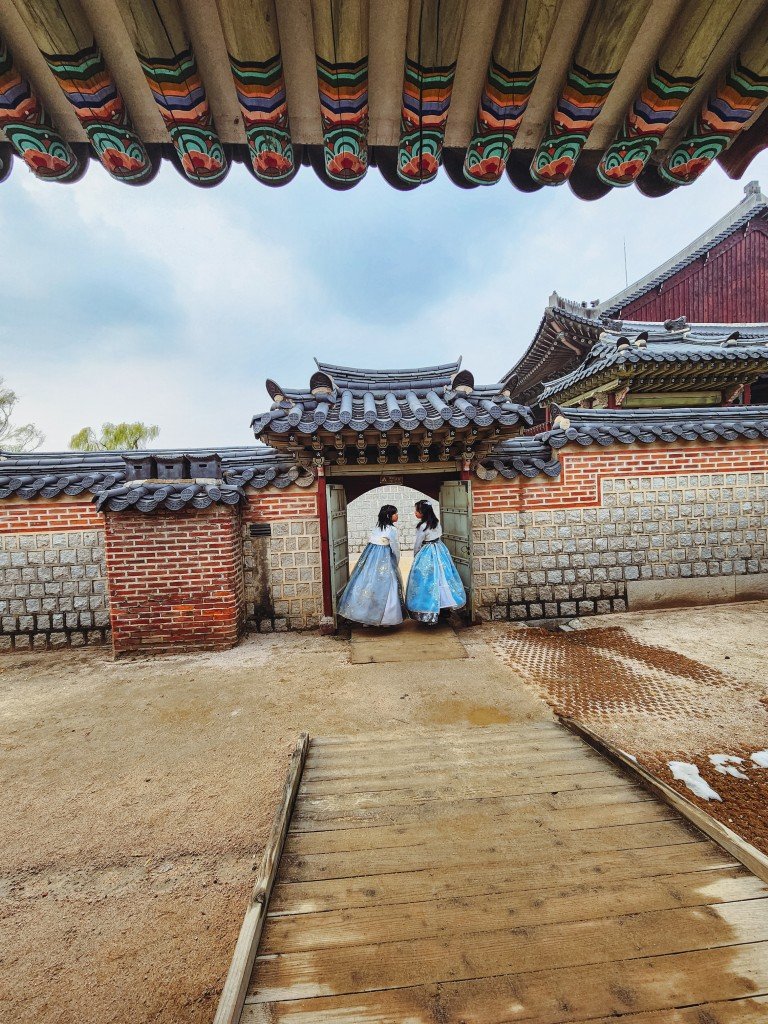
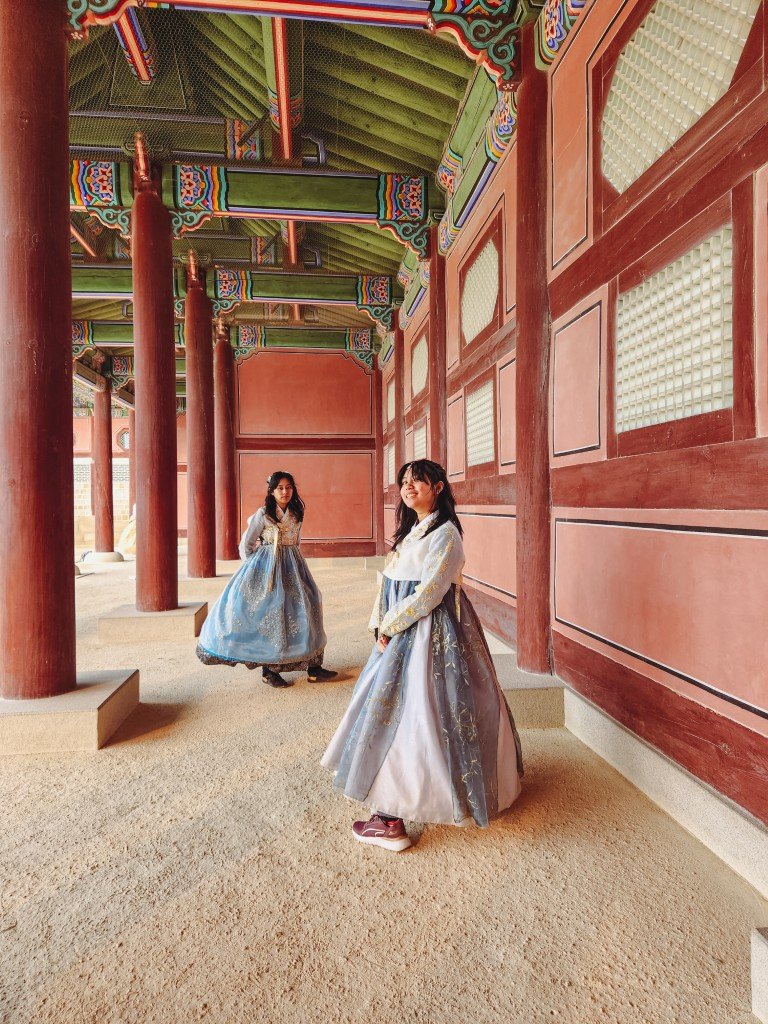
Step into Korea’s royal past at Gyeongbokgung Palace, one of Seoul’s top family attractions. Sounds boring? Here’s a tip to get them excited: rent a hanbok (traditional Korean clothing) for your children before entering. Not only do kids love dressing up as little princes and princesses, but they’ll also get free palace admission. I’ve seen tourists dressed up as warriors and assassins, so let their imagination run wild!
Time your visit with the changing of the guard ceremony – it’s like watching history come alive, complete with colorful costumes and ceremonial music. I’ve seen different changing of the guards ceremonies, and this is one of the more exciting ones.
Explore Bukchon Hanok Village
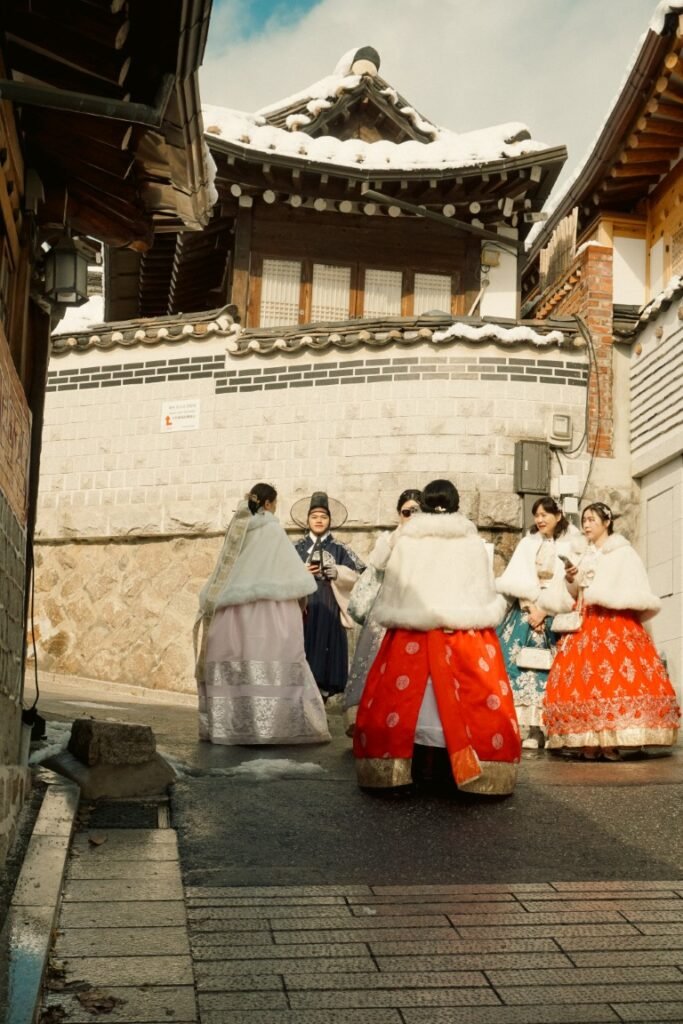
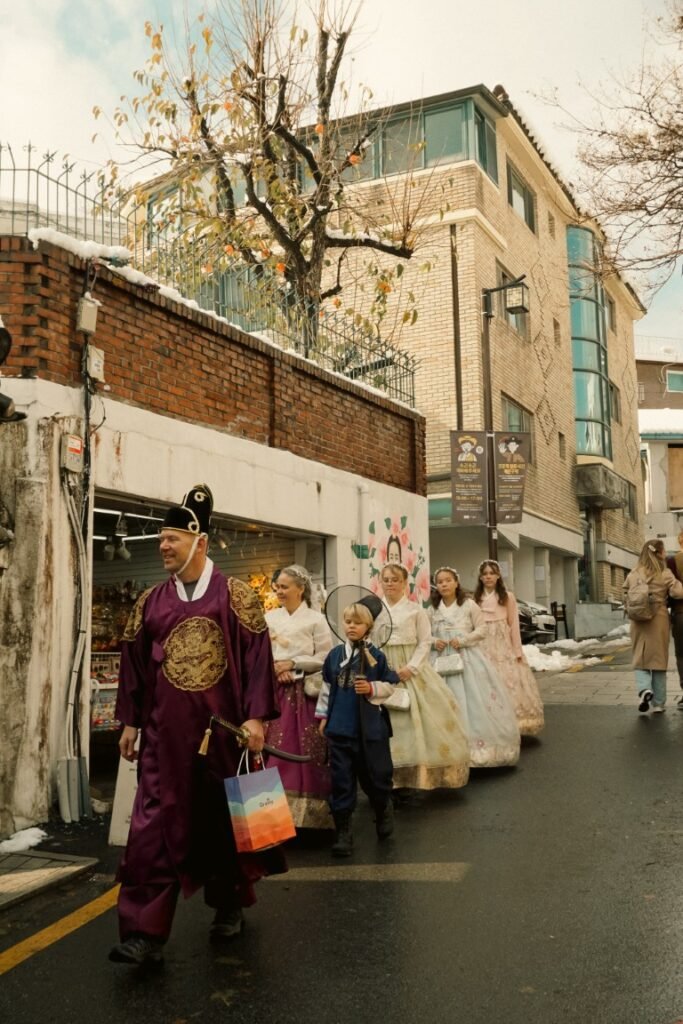
For a deeper dive into traditional Korea, explore the picturesque alleys of Bukchon Hanok Village, where ancient Korean houses offer a glimpse into old Seoul. You can also rent a hanbok and even stay at a hanok overnight. Many houses also host cultural workshops perfect for kids’ activities in Seoul, where they can try calligraphy, tea ceremonies, or mask painting.
Nearby, the charming neighborhoods of Insadong and Ikseondong are filled with artisan shops, tea houses, and opportunities for cultural crafts like making traditional fans or pottery. Ssamziegel in Insadong is a must-stop for kids who love arts and crafts. You can also do cafe hopping in Ikseondong for Instagram-worthy desserts!
Theme Parks and Entertainment
Going to a theme park is a no-brainer if you’re bringing your kids to Seoul. And so are fun shows. Here’s what we recommend:
Visit Lotte World
When it comes to what to do with kids in Seoul, Lotte World tops the list. This massive indoor-outdoor complex is one of Seoul’s best attractions for kids, combining rides for all ages, regular parades, an ice skating rink, and even a folk museum. This magical place combines traditional rides with modern attractions, featuring gentle options for smaller children and thrilling roller coasters for the brave ones.
The connected Lotte World Mall houses an aquarium and dozens of family-friendly restaurants, making it easy to spend a full day here without running out of things to do. I went here when I was a teen. It’s an experience you want your kids to have.
Take a day trip to Everland
For an even bigger adventure, take a day trip to Everland, South Korea’s largest theme park. Here, you’ll find world-class roller coasters, a safari zoo, and seasonal festivals that transform the park throughout the year. We didn’t do this anymore as my teens were not into roller coasters.
Watch the highly entertaining NANTA show
For evening entertainment, don’t miss the NANTA show, a hilarious non-verbal performance combining comedy, acrobatics, and cooking that delights audiences of all ages. We originally planned to watch this but since our one-week itinerary was already packed, we decided to skip it. However, if you have the time, it’s highly recommended. The reviews all say the show’s universal humor and lack of language barrier make it perfect for international families.
Interactive Museums and Indoor Activities
Most activities and attractions in Seoul are outdoors, so these family-friendly activities are great on rainy days or when it’s freezing cold outside:
Visit COEX Aquarium
Seoul’s family attractions include numerous museums designed with kids in mind. The COEX Aquarium houses over 40,000 marine creatures, with themed underwater tunnels and touch pools that let children get up close with sea life.
Frankly, I don’t associate Seoul with the sea, so this can be skipped. However, if your children are into underwater creatures, go for it. Besides, it can be a two-for-one experience since the famous Starfield Library (which you will likely want to see) is in the same complex.
Check out Starfield Library
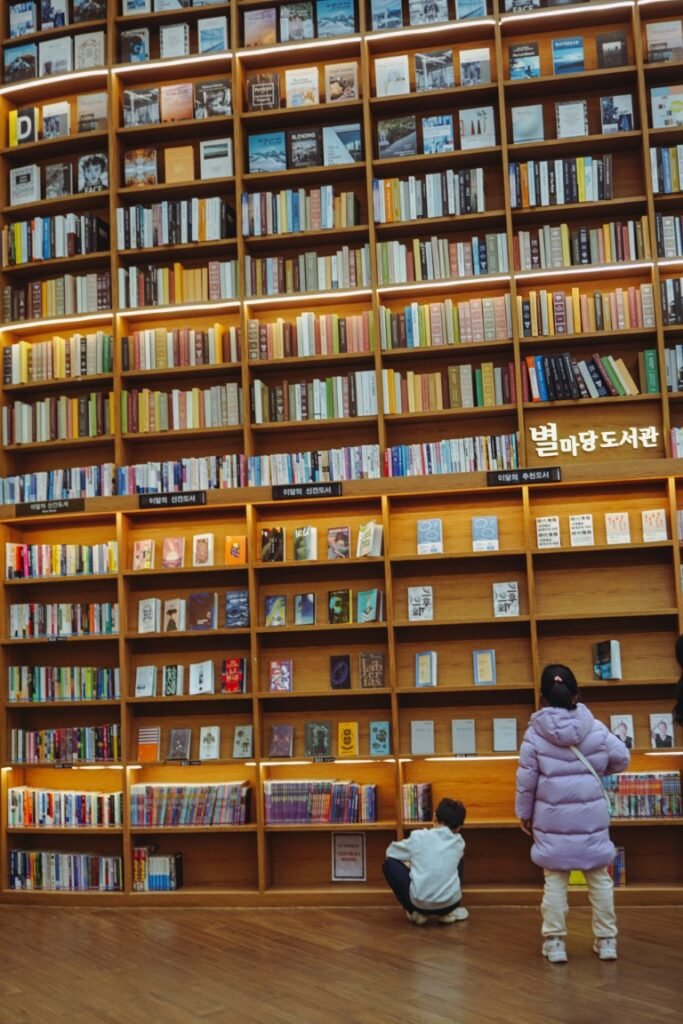
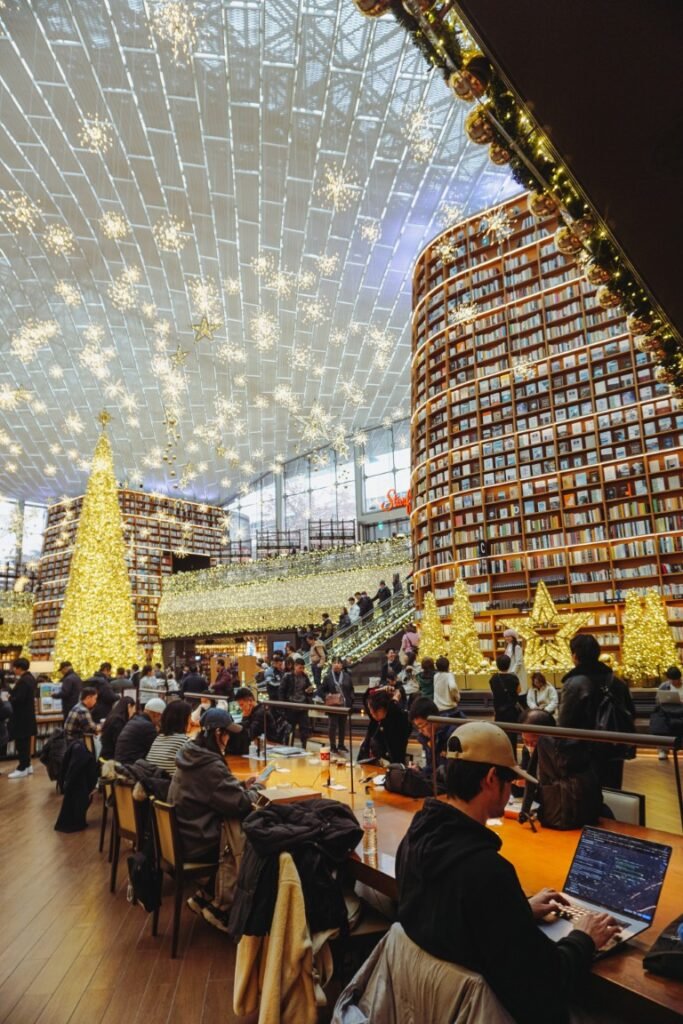
The stunning Starfield Library in COEX Mall provides a peaceful retreat with towering bookshelves and cozy reading nooks – it’s also one of Seoul’s most impressive photo opportunities. We enjoyed taking lots of photos. Young kids could care less, but if they’re book lovers, they might find this place interesting.
Learn about history at the National Museum of Korea
The National Museum of Korea deserves special mention for its dedicated Children’s Museum section, featuring interactive exhibits that bring Korean history to life. It features hands-on exhibits specially designed for kids aged 3-12, where they can touch, play, and learn about Korean history through interactive displays. You can skip this, though, if you have a tight schedule.
Outdoor Adventures and Nature Escapes
Seoul has beautiful parks, mountains, and natural landscapes. These were in our original itinerary, but we missed out for lack of time. But we’ll definitely do these when we return:
See Seoul Forest Park
For outdoor fun in Seoul with kids, head to Seoul Forest Park, often called Seoul’s Central Park. This sprawling green space offers multiple playgrounds, a deer-feeding experience, a butterfly conservatory, and peaceful walking trails. During summer months, your kids can splash in fountains, while autumn brings beautiful colors and falling leaves to play in.
Go up N Seoul Tower
For spectacular city views, take the cable car up to N Seoul Tower, an adventure in itself that kids absolutely love. They can add locks to the famous “Locks of Love” fence. The observatory also offers interactive displays about Seoul’s history. There’s also a teddy bear museum, character shops, and several family-friendly restaurants including a rotating restaurant with panoramic views.
Stroll along Cheonggyecheon Stream and Banpo Bridge
Don’t miss an evening stroll along Cheonggyecheon Stream, a restored waterway running through downtown Seoul. Your kids can dip their toes in the shallow water and enjoy the art installations that change with the seasons. For a magical evening experience, visit Banpo Bridge to see the Moonlight Rainbow Fountain, where water, light, and music combine in a spectacular show.
Take a Han River cruise
For a different perspective of the city, take a Han River cruise. Evening trips offer spectacular views of Seoul’s illuminated skyline. Several cruise companies operate from different terminals along the river, with Yeouido being the most popular departure point. For something special, try the themed cruises, which include live music, fireworks, and buffets.
Where to Stay in Seoul With Kids
Seoul is smaller than other major cities. Tokyo, for instance, is 3.6 times bigger than Seoul. But it’s still huge that you’ll need public transportation to go from one district to another. Here are some recommended areas to stay in Seoul with kids. Each area offers different advantages for families, so consider your priorities when picking your base.
Myeongdong
This central location is perfect for first-time visitors to Seoul with kids. Myeongdong puts you within walking distance of major attractions and offers excellent public transportation connections to all parts of the city. The streets are well-lit and safe, making evening walks with children comfortable. You’ll find plenty of family-friendly restaurants, from international chains to local eateries with English menus.
The underground shopping centers provide convenient shelter during bad weather, and most hotels in the area offer family rooms or connecting options. While the area can get crowded during peak shopping hours, it usually quiets down in the evening. However, as it’s a hot tourist area, expect rates to be higher.
Hongdae
If your family loves a lively atmosphere, Hongdae offers a perfect blend of entertainment and convenience. The area comes alive with street performers and musicians, providing free entertainment that kids love. You’ll find numerous kid-friendly cafes, including animal cafes and character-themed eateries.
Hotels here tend to be more affordable than in Myeongdong, and many offer apartment-style accommodations perfect for families. The excellent transport links make it easy to reach major attractions, and the university atmosphere keeps the area feeling safe and energetic.
Jamsil
If your itinerary is heavy on theme parks and outdoor activities, you might consider staying in Jamsil. Located near Lotte World and Olympic Park, this residential area offers a more local experience while maintaining easy access to entertainment. The neighborhood is quieter than central areas, making it ideal for families who prefer peaceful evenings.
Hotels here often feature larger rooms than those in the city center, and you’ll find plenty of local restaurants where kids can try Korean food in a less touristy environment.
Insadong
If you’re more interested in Korean culture, Insadong provides an authentic experience with modern comforts. This traditional neighborhood puts you close to palaces, museums, and cultural workshops.
Many hotels here offer hanok stays, giving children the unique experience of sleeping in a traditional Korean house. The area is walkable and filled with souvenir shops and traditional tea houses where kids can try Korean snacks and drinks.
Gangnam
If you’re looking for upscale accommodations and modern conveniences will appreciate Gangnam. This district offers luxury hotels with family-friendly amenities like pools and kids’ clubs. The COEX Mall complex provides endless entertainment options, from the aquarium to the Starfield Library.
While accommodation costs are higher here, you’ll find excellent medical facilities and international restaurants that can be reassuring for families traveling with young children.
Yeouido
This business district transforms into a family paradise on weekends. Located along the Han River, Yeouido offers easy access to riverside parks and cycling paths. The area is home to many international hotels with spectacular river views, and the IFC Mall provides shopping and dining options. Families particularly enjoy the weekend markets and seasonal festivals in Yeouido Hangang Park.
Dongdaemun
Perfect for families who love night activities, Dongdaemun offers unique experiences with its late-night shopping and cultural attractions. The area around Dongdaemun Design Plaza (DDP) features futuristic architecture and regular cultural events that fascinate children. Hotels here often cater to shopping-focused tourists but can provide good value for families, especially those with older kids who enjoy evening activities.
Chungmuro
This central yet underrated neighborhood offers excellent value for families. Located between Myeongdong and Dongdaemun, Chungmuro provides easy access to major attractions while being slightly removed from the tourist crowds. Hotels tend to be more affordable, and many offer larger family rooms. The area has a local feel with plenty of authentic restaurants and small shops, plus it’s close to Namsangol Hanok Village for cultural experiences.
We stayed in Chungmuro, as it’s nearby Myeongdong, Dongdaemun, Jongno, and Anguk, where most of the tourist spots are. It’s a bit farther from Hongdae and Gangnam, but that’s fine. A 30- to 40-minute train ride is not so bad.
Where to Eat in Seoul With Kids
Seoul is a great city for foodies, and there are many kid-friendly restaurants to choose from. You really won’t have a problem finding places to eat, even if your kids are picky eaters.
Kid-Friendly Korean Dishes
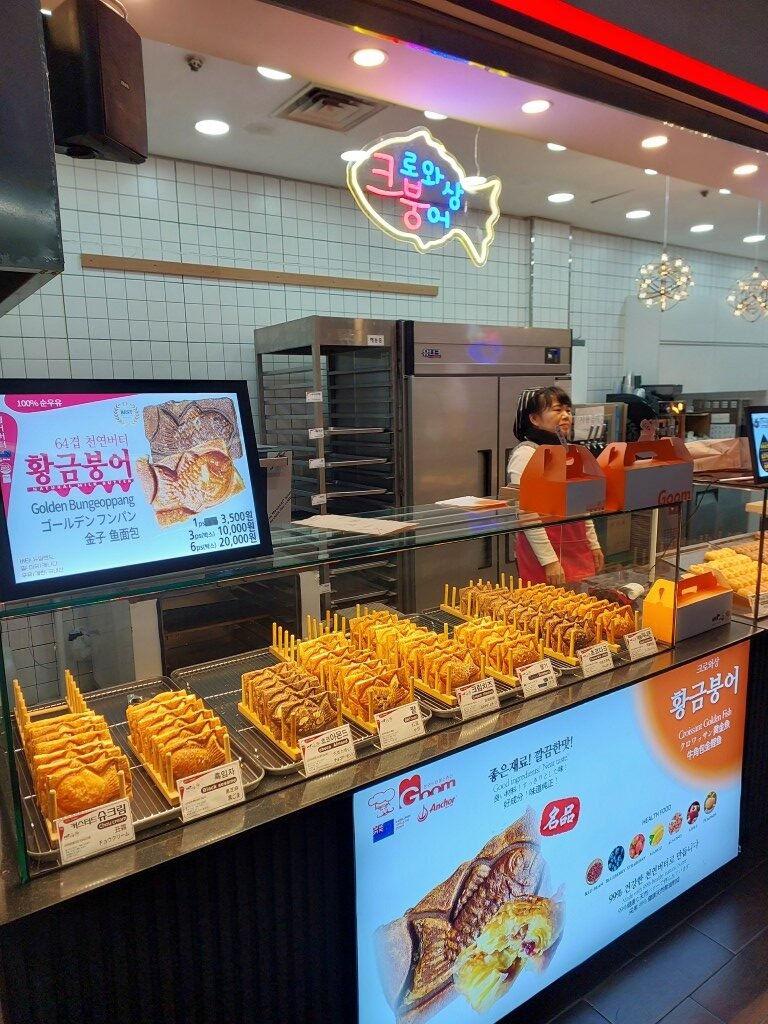
It would be a shame if you only eat at fast food chains or Western food. Expose your kids to Korean cuisine. Don’t be afraid, not every Korean dish is spicy! Start your culinary journey with mild, familiar flavors that most children enjoy.
Bulgogi (sweet marinated beef) is usually an instant hit with kids – it’s not spicy and has a pleasant sweet-savory taste that reminds many children of teriyaki. Japchae (sweet potato noodles) offers a familiar noodle texture with a mild flavor, and kids love the colorful vegetables mixed in. Mandu (Korean dumplings) come in both steamed and fried varieties, making perfect kid-sized bites. For rice lovers, try bibimbap without the spicy sauce, It’s essentially a colorful rice bowl where children can pick and choose their favorite toppings.
Korean Fried Chicken
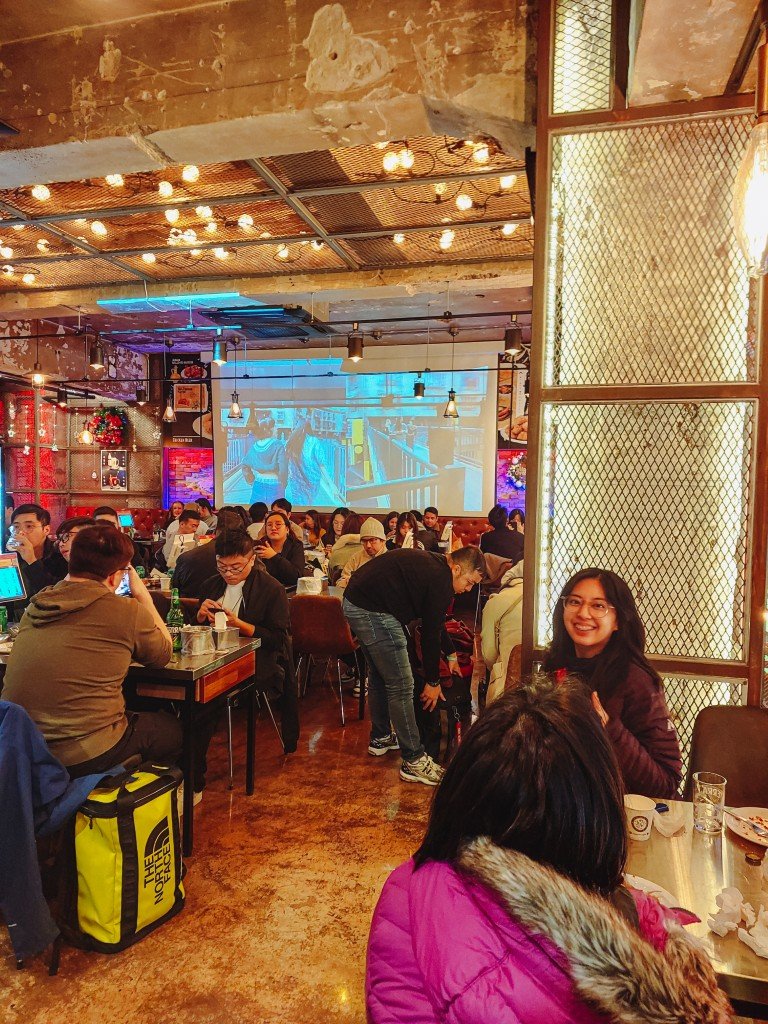
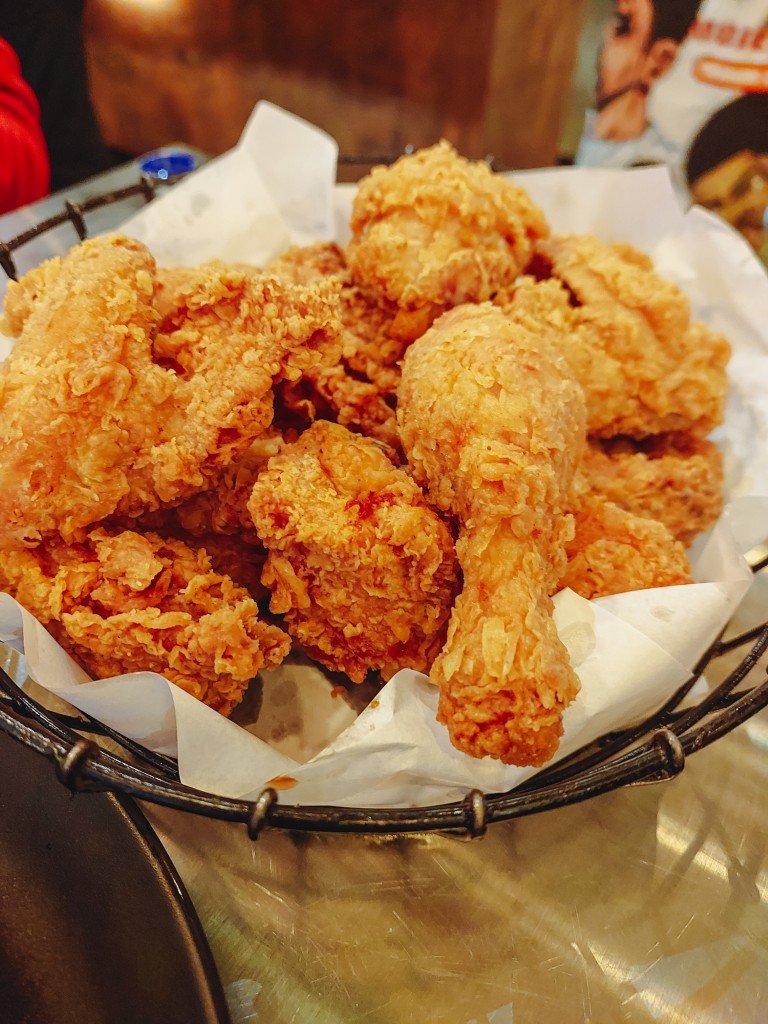
No family trip to Seoul is complete without trying Korean fried chicken, or “chimaek” (chicken and beer – though kids can have soda instead!). Korean fried chicken is a cultural phenomenon that even picky eaters tend to love. The chicken is double-fried to achieve an incredibly crispy exterior while keeping the meat juicy.
We ate at popular chains like BBQ, Kkanbu, and Kyochon, which offer various flavors ranging from plain crispy (perfect for kids) to sweet soy garlic and mild spicy options. The portions are generous and meant for sharing, making it an economical family dinner option.
Interactive Dining Experiences
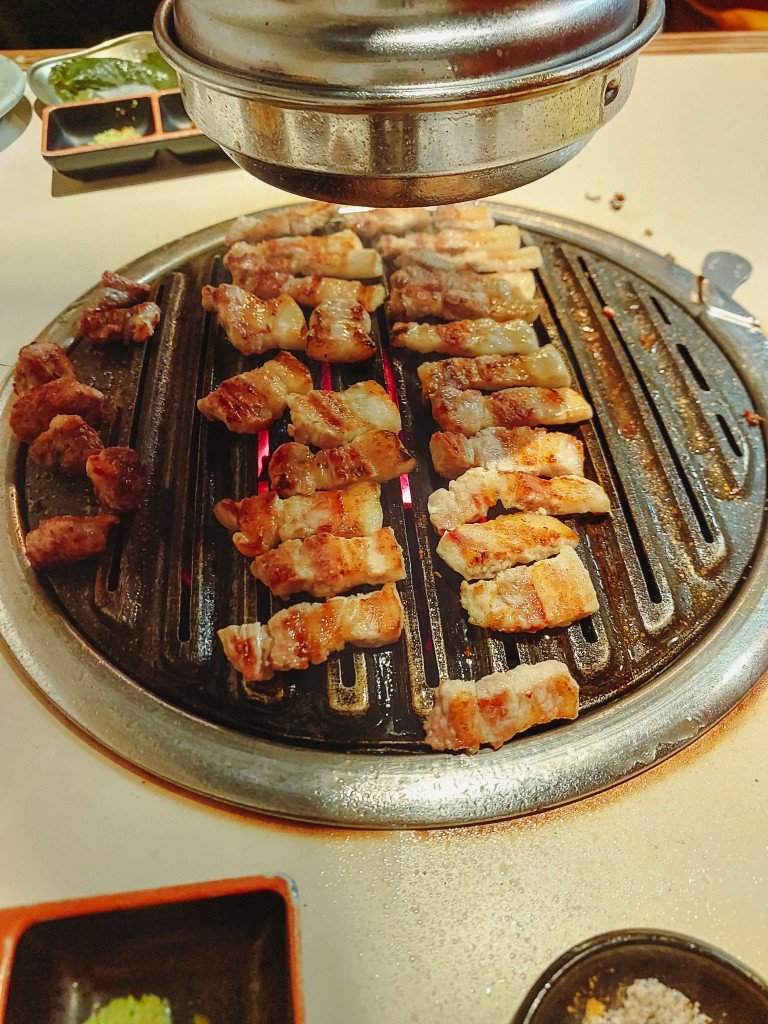
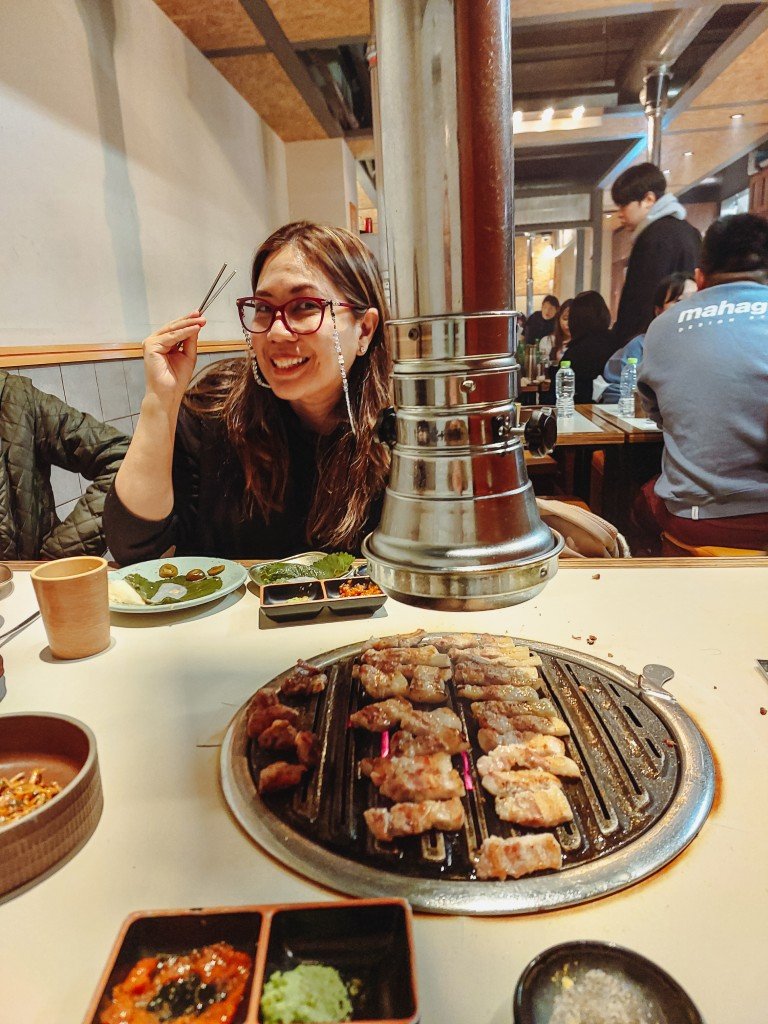
Your kids must have a Korean BBQ experience! Korean BBQ restaurants provide the perfect family dining adventure. Your kids will enjoy watching their food cook right at the table, and they can even help prepare the meal (with supervision). Start with samgyeopsal (pork belly) or gyeonjeongsal (non-spicy pork), which are mild and familiar. The array of small side dishes (banchan) that come with every Korean meal turns dinner into an exploration, letting children sample different tastes safely.
We loved eating at Korean BBQ restaurants back home but especially in Seoul. It’s just something we can’t get enough of. We tried the very popular Wangbijip in Myeongdong and the Michelin-starred Ggapdung in Seongsudong.
Street Food Adventures
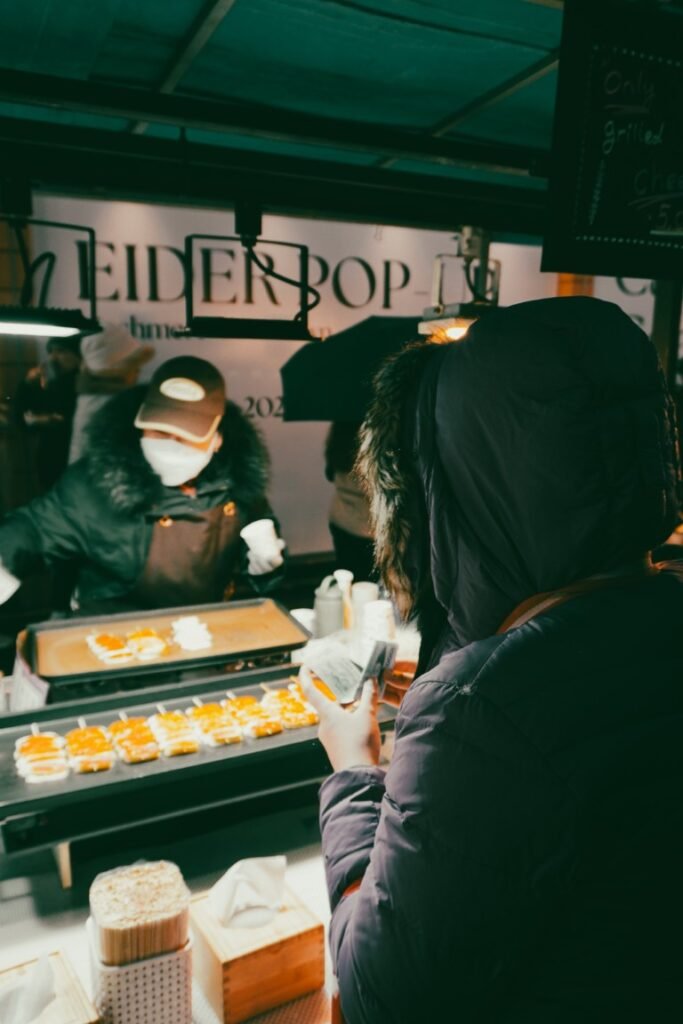
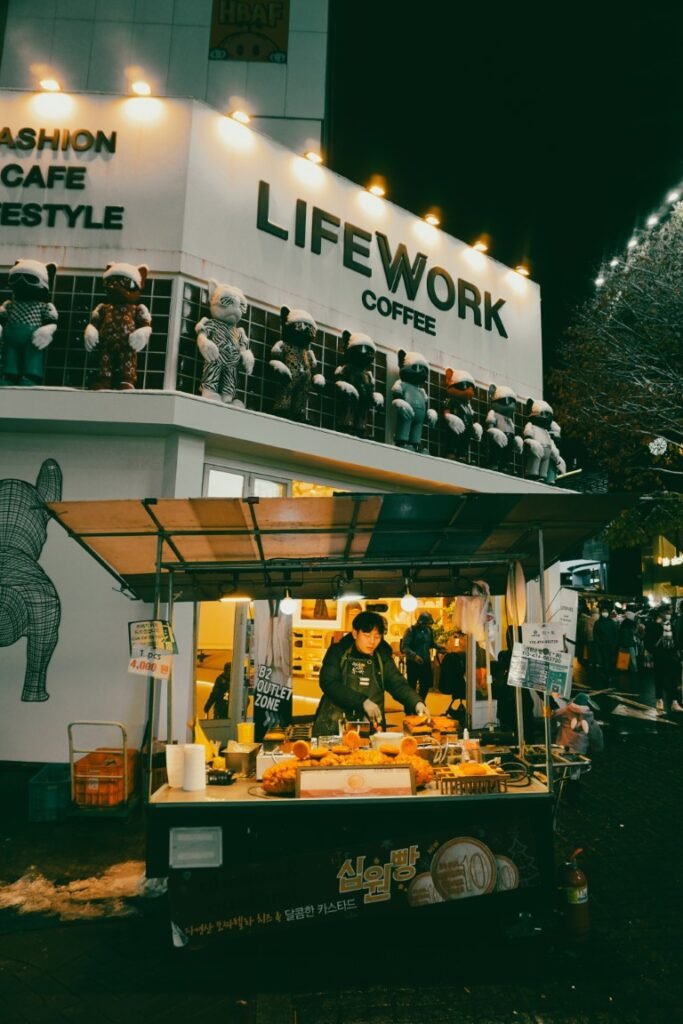
Seoul’s street food scene is a treasure trove of kid-friendly treats. I guarantee your kids will enjoy this experience. Start with hotteok, sweet pancakes filled with brown sugar and nuts – they’re like a warm cookie and a pancake combined. Bungeoppang (fish-shaped pastries filled with sweet red bean or custard) are fun to eat and not too sweet. Korean corn dogs take the familiar hot dog to new heights with creative coatings like crispy potatoes or french fries. Don’t miss gyeran-bbang (egg bread), a warm, sweet-savory treat that’s like a portable breakfast. Consider taking a street food tour or DIY.
Desserts and Sweet Treats
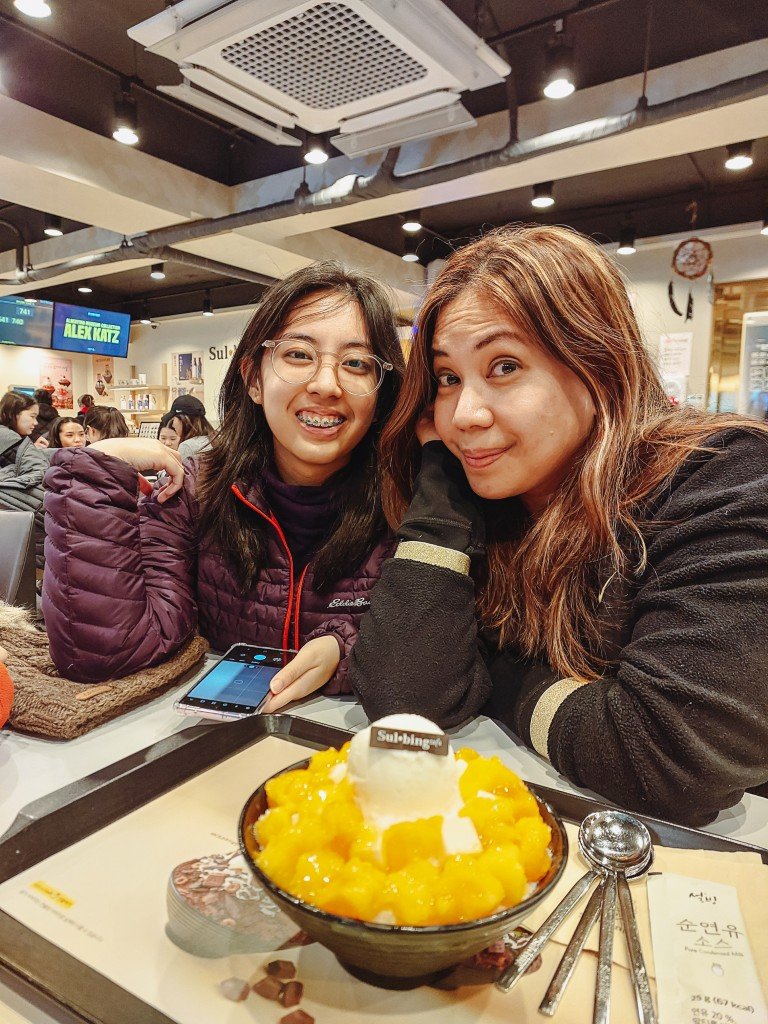
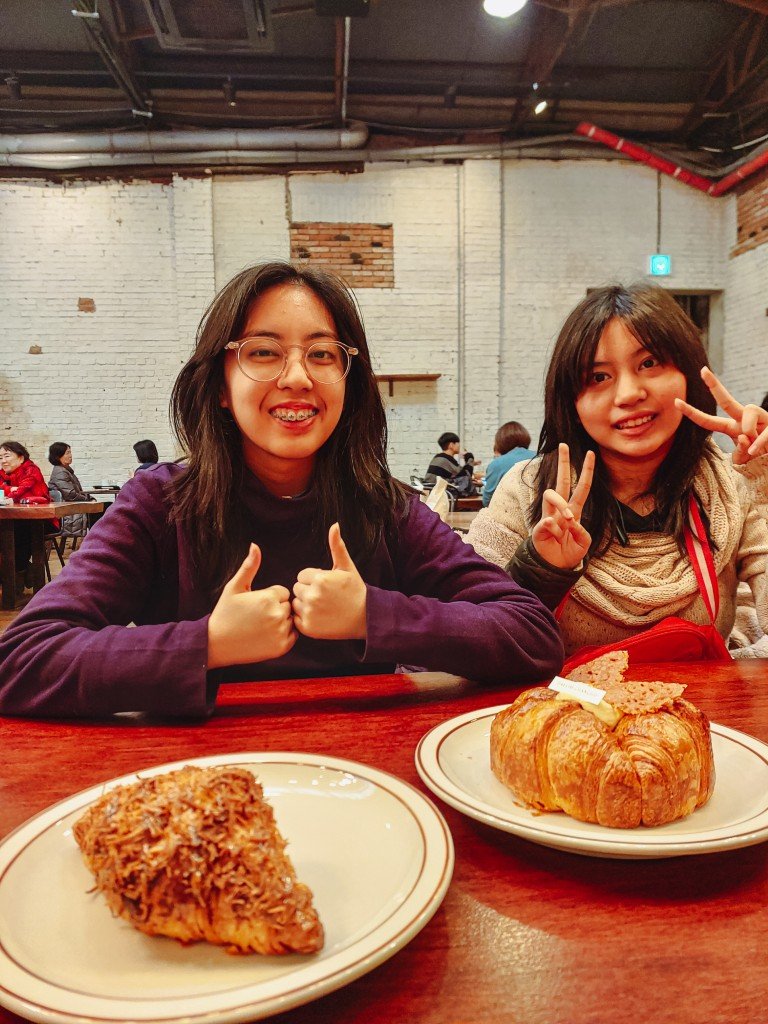
Korean dessert cafes are made for families. Pat bingsu (shaved ice) comes in endless varieties, from traditional red bean to kid-friendly favorites like chocolate or fruit. Sulbing in Myeongdon is highly recommended.
Many cafes create elaborate presentations that are as fun to photograph as they are to eat. Even Starbucks in Seoul has coffees and desserts available only in Korea. I recommend you do cafe hopping because every cafe and bakery has something unique to offer. Character cafes, especially popular in areas like Hongdae, serve adorable dishes designed to look like popular cartoon characters. We tried Cafe Onion, Cheonsudang Bakery, Jayeondo, London Bagel Museum, and Daerim. And honestly, that’s only a fraction of what we shortlisted.
Food Courts and Markets
Seoul’s department store food courts are perfect for families, offering a wide variety of options in a convenient setting. COEX Mall and Lotte Department Store food courts have everything from Korean classics to international cuisine, with plenty of seating and high chairs available. Traditional markets like Gwangjang Market or Tongin Market let families try small portions of different foods, making it easy to experiment without committing to full meals.
International Options
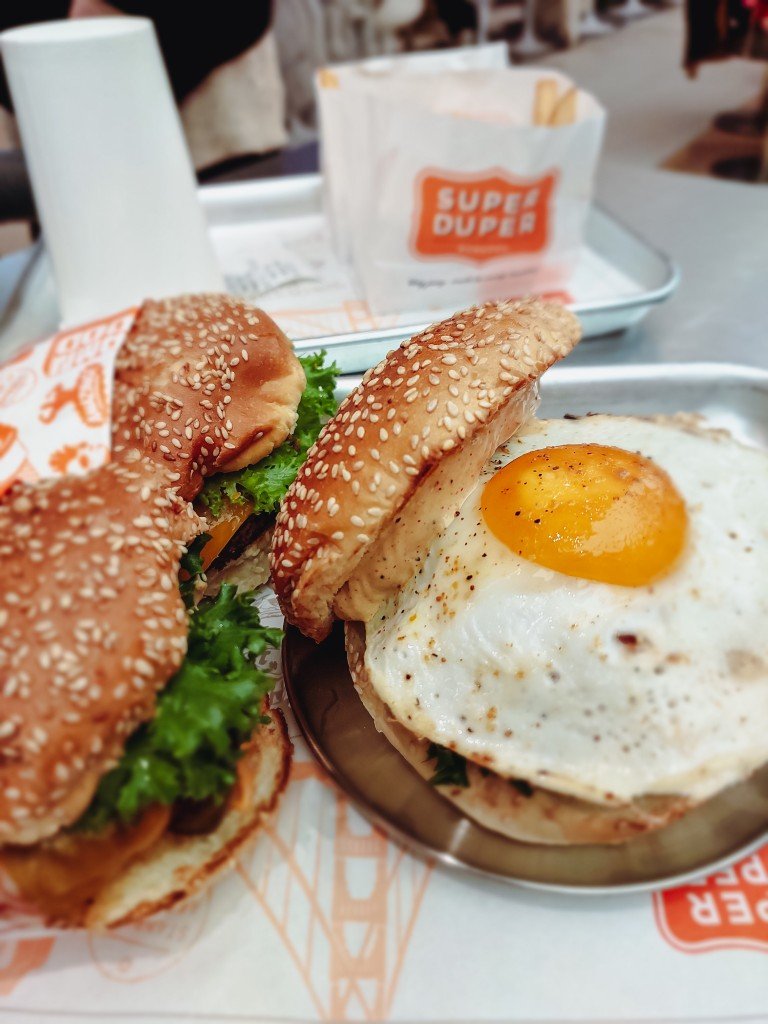
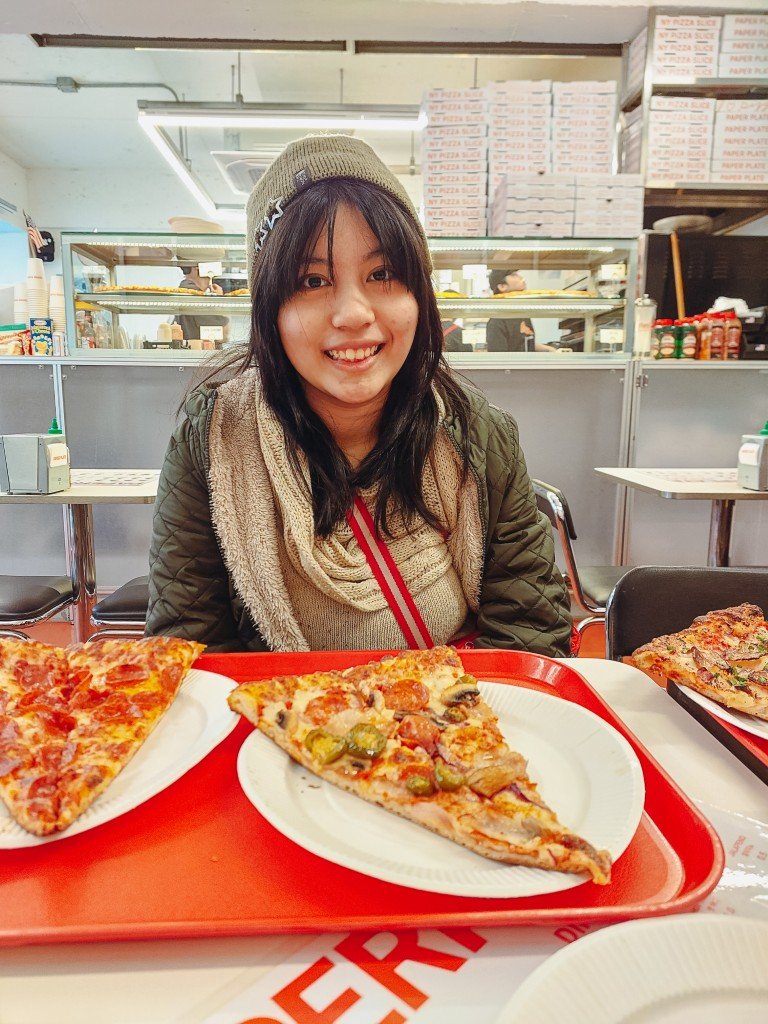
For those days when your kids need a taste of home, Seoul offers plenty of Western and Asian dining options. Major shopping areas like Myeongdong and Dongdaemun have familiar fast-food chains, while areas like Itaewon feature international restaurants serving everything from pizza to burgers. Many Korean cafes also offer western-style pastries and sandwiches that make perfect quick lunches.
Some of our favorite eats include Oreno Ramen in Anguk, Little Hanoi in Ehwa Women’s University, Super Duper in COEX Mall, Paper Plate in Seongsu, and Homeboy Seoul near Gyeongbokgung Palace (our all-time fave!).
Tips for Dining with Kids in Seoul
- Many restaurants offer pictures on their menus, making it easy to order even without speaking Korean
- Keep some mild snacks from convenience stores as backup options
- Learn the phrase “안 매워요” (an maewoyo – not spicy) to request non-spicy versions of dishes
- Consider timing meals slightly earlier than peak hours to avoid crowds
- Major shopping areas often have restaurants with English menus and picture menus
- Don’t hesitate to ask for extra plates to share dishes
- Many restaurants provide hot water instead of cold water – request “차가운 물” (chagaun mul) for cold water
Remember that Korean dining is typically family-style, making it easy to share dishes and let kids try small portions of different foods. This communal style of eating can make mealtimes more relaxed and fun for everyone. Most restaurants are also quite accommodating to families with children, often providing booster seats and extra napkins without being asked.
When to Go to Seoul With Kids
The best time to visit Seoul with kids is during the spring (March-May) or fall (September-November) when the weather is mild. The summer can be very hot and humid, and the winter can be cold and snowy. We went during the last week of November until the first week of November, so we experience the last days of autumn and the start of winter (and the largest snowfall in Seoul in 117 years!)
Here are some things to consider when planning your trip:
- Weather: The best time to visit Seoul with kids is during the spring (March-May) or fall (September-November) when the weather is mild. The average temperature in Seoul during these months is between 10-20 degrees Celsius (50-68 degrees Fahrenheit).
- School holidays: If you are traveling with school-aged children, be sure to check the school calendar to avoid visiting during the peak travel times. The summer vacation in South Korea is from July to August, and the winter vacation is from December to January.
- Events: There are many festivals and events held in Seoul throughout the year. Some of the most popular events include the Seoul Lantern Festival (February), the Seoul International Fireworks Festival (August), and the Seoul Christmas Festival (December).
- Budget: Seoul is a relatively expensive city, but there are ways to save money. One way to save money is to eat at local restaurants instead of tourist traps. Another way to save money is to use public transportation instead of taxis.
How Long to Stay in Seoul with Kids
Planning the right length of stay in Seoul is crucial for a successful family trip. While you could spend weeks exploring this vibrant city, here’s a breakdown of what you can realistically accomplish in different time frames:
5 Days (Minimum Recommended Stay)
Five days gives you enough time to see Seoul’s major highlights without exhausting young travelers. This duration allows you to:
- Adjust to the time difference (especially important with children)
- Visit one major theme park (Lotte World or Everland)
- Explore two palaces and try on hanbok
- Experience Korean cuisine at a relaxed pace
- Spend time at COEX Mall and Aquarium
- Take an evening Han River cruise
- Do some souvenir shopping
However, with only five days, you’ll need to prioritize activities and likely skip day trips outside the city. Unless you’ve been to Seoul before, I don’t recommend only five days.
7-8 Days (Ideal First Visit)
A week to eight days provides the sweet spot for families visiting Seoul. This timeframe allows you to:
- See all major attractions without rushing
- Include one or two day trips (perhaps Nami Island or Everland)
- Have backup days in case of bad weather
- Take rest days when kids get tired
- Explore different neighborhoods
- Try more local experiences
- Include downtime for shopping and casual exploration
This duration also gives you flexibility to adjust plans based on your children’s interests and energy levels. We spent a week in Seoul, allowing us to see and do plenty of things. But we also missed quite a number of places in our original itinerary.
10-14 Days (Comprehensive Experience)
If you have two weeks, you can truly immerse your family in Seoul and include several day trips. This length of stay allows you to:
- Visit all major attractions at a leisurely pace
- Take multiple day trips to nearby destinations
- Participate in cultural workshops and classes
- Have full rest days between activities
- Explore lesser-known neighborhoods
- Take cooking classes or other hands-on experiences
- Really get to know the public transportation system
- Experience local life beyond tourist areas
I would recommend 10 days, which I think is the ideal time. If you have two weeks, you can do more day trips outside Seoul or go to another city like Busan.
Factors to Consider When Planning Duration
- Children’s ages: Younger kids need more downtime and shorter activity days
- Season: Summer heat or winter cold might require more indoor days
- Jet lag: Plan 1-2 days at the start for adjustment
- Travel style: Some families like to see everything, others prefer a relaxed pace
- Budget: Longer stays need careful budget planning, but can be more cost-effective per day
- Day trip interests: Adding day trips requires at least one full day each
Sample 7-Day Itinerary
- Day 1: Arrival + Myeongdong shopping & streetfood
- Day 2: Gyeongbokgung Palace
- Day 3: Lotte World or Everland
- Day 4: Bukchon Hanok Village + Insadong + Ikseondong
- Day 5: COEX Aquarium + Starfield Library + Gangnam
- Day 6: Seoul Forest + Han River cruise
- Day 7: N Seoul Tower + last-minute shopping
Tips for Any Duration
- Don’t try to pack too much into each day (believe me, you can’t do everything you set out to do)
- Plan one major activity per day with flexible add-ons (for example, Gyeongbokgung Palace was an entire day, since choosing a hanbok took an hour!)
- Include rest time in the afternoon for young children (if you have older kids or teens, take a break at a cafe)
- Keep evening activities light, especially in the first few days (we stayed up until 9pm or 10pm, so we ended up waking up late the next day)
- Build in buffer time for unexpected discoveries or weather changes (we had to skip a day trip to Suwon because of the sudden and heavy snowfall)
- Consider your hotel location when planning daily activities (this is crucial because commute time can eat up into your schedule)
- Mix active days with relaxed ones (if you plan to visit a theme park, for example, visit a nature park at a slower pace the next day)
Remember that quality time experiencing Seoul is more valuable than checking off every attraction. Even with a shorter stay, focus on creating memorable experiences rather than rushing through a packed itinerary. Identify your non-negotiables and be ready to give up on your nice-to-see list because even a week is not enough.
Getting Around Seoul with Kids
Seoul’s public transportation system is incredibly family-friendly. We took the subway most of the time and just took the bus when we went outside of Seoul.
- Subway: The subway is the most popular way to get around Seoul. It is efficient, affordable, and clean. The subway system features clear English signage, elevator access, and priority seating for families. Children under six ride free, and older kids get discounted fares. Most stations connect to underground shopping centers, providing shelter during bad weather.
- Bus: Buses complement the subway system with extensive coverage. While slightly more challenging to navigate than the subway, most stops are announced in English, and many buses have designated spaces for strollers.
- Taxi: Taxis are abundant and safe, with many drivers happy to help families with luggage or strollers. The Kakao T app offers English-language taxi booking, making it easy to get around when little legs are tired. While they are a convenient way to get around Seoul, they can be expensive. We had a hard time communicating with taxi drivers, though, so make sure you show your destination in Korean, as most of them don’t understand English.
- Walking: Seoul is a very walkable city. Many of the major tourist attractions are located within walking distance of each other. For example, Insadong, Ikseondong, Seongsudong, and Hongdae are easily explored on foot. However, areas like Gangnam and Itaewon are not.
If you are planning on using public transportation in Seoul, I recommend purchasing a T-money card. A T-money card is a prepaid card that can be used on the subway, bus, and some taxis. T-money cards can be purchased at most convenience stores and subway stations.
Frequently Asked Questions: Seoul with Kids
Safety and Health
Is Seoul safe for families with children? Seoul is extremely safe for families. The city has low crime rates, well-lit streets, and a culture that’s very protective of children. It’s common to see children using public transportation alone and families out late at night. We’ve never been worried about safety when we were there. But, of course, don’t be complacent and always use your common sense.
What about medical care for children? Seoul has excellent medical facilities, including several international hospitals with English-speaking staff. Major hospitals like Severance and Samsung Medical Center have pediatric departments and 24-hour emergency rooms. Keep your travel insurance information handy.
Is the tap water safe to drink? While tap water in Seoul is technically safe to drink, most locals drink filtered or bottled water. Bottled water is readily available and inexpensive at convenience stores. Restaurants also serve water for free.
Transportation
How stroller-friendly is Seoul? Most major attractions and shopping areas are stroller-friendly, but some older areas and traditional markets may have uneven surfaces. Most subway stations have elevators, though they can sometimes be hard to find. Consider bringing a lightweight, foldable stroller.
Is public transportation easy to navigate with kids? Yes! Seoul’s public transportation is very family-friendly. Children under six ride free on the subway and buses, while older kids get discounts. Subway stations have clean restrooms (a pleasant surprise for us) and clear English signage. Many buses have designated spaces for strollers.
Should we take taxis with kids? Taxis in Seoul are safe and relatively affordable. However, car seats are not common in taxis. If traveling with young children, you might want to bring your own portable car seat. It can also be challenging to communicate in English, so make sure you show your destination in Korean.
Food and Dining
What if my child is a picky eater? Seoul has plenty of Western food options in major areas. You can find familiar chains like McDonald’s and Pizza Hut, plus many Korean restaurants offer non-spicy options for children. Convenience stores stock many kid-friendly snacks.
How can we handle food allergies? Get allergy cards written in Korean before your trip. Many restaurants in tourist areas understand basic English, but having written allergies in Korean is helpful. Chain restaurants often have allergen information available.
Are there high chairs in restaurants? Many restaurants, especially in family-friendly areas, have high chairs. However, they’re not as universally available as in some Western countries. Korean-style floor seating restaurants might be more comfortable for families as children can move around more freely.
Accommodation
Do hotels provide cribs/cots? Most international hotels provide cribs upon request, but it’s best to request in advance. Local hotels might not have this service, so check before booking.
Are hotel rooms big enough for families? Korean hotel rooms can be smaller than Western standards. Consider booking a family room, connecting rooms, or an apartment-style accommodation for more space. Many hotels offer special family packages. We got a loft-style hotel room that’s big enough for four.
Language and Communication
How can we manage with limited Korean? Major tourist areas, attractions, and hotels usually have English-speaking staff. Download translation apps like Papago or Google Translate. Learning basic phrases like “thank you” (감사합니다/gamsahamnida) and “bathroom” (화장실/hwajangshil) can be helpful.
Is English signage common? Yes, most public transportation, major attractions, and shopping areas have English signage. Tourist areas often have information in multiple languages.
Weather and Clothing
What should kids wear in different seasons?
- Spring/Fall: Light layers, comfortable walking shoes
- Summer: Light, breathable clothing, sun protection
- Winter: Warm layers, thermal wear, winter boots
- Indoors: Many places are well-heated/air-conditioned, so layers are key
Practical Matters
Are there changing facilities and nursing rooms? Most shopping malls, department stores, and major attractions have clean changing facilities and nursing rooms. Look for signs saying “Family Restroom” or “Nursing Room.”
Can we find diapers and baby supplies? Diapers, wipes, and basic baby supplies are readily available at convenience stores, pharmacies, and large retailers like Olive Young. However, specific brands might differ from home.
What about shopping with kids? Major shopping areas have family restrooms and often play areas. Department stores usually have dedicated children’s floors with play spaces and family facilities.
Entertainment
Are theme parks worth it with young children? Both Lotte World and Everland have areas dedicated to young children. Lotte World might be better for younger kids as it’s mostly indoor and more centrally located.
What if it rains? Seoul has plenty of indoor attractions perfect for rainy days: COEX Aquarium, children’s museums, indoor theme parks, and massive shopping centers with entertainment options.
Are there age restrictions for attractions? Most attractions are suitable for all ages, but some rides at theme parks have height/age restrictions. Check official websites for specific requirements.
Money Matters
Is Seoul expensive with kids? While Seoul can be expensive, there are many ways to save:
- Children under six often get free admission to attractions
- Many museums are free or offer family discounts
- Public transportation is affordable
- Street food and local restaurants are reasonably priced
Do we need cash for kid-related activities? While credit cards are widely accepted, keep some cash for street food, small shops, and transportation. Many attractions offer discounts for cash payments.

